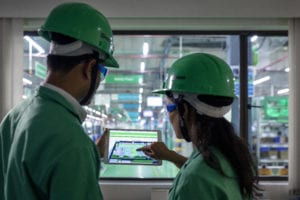
My work takes me to many places around the world. During these business trips, I find myself in all types of buildings–hotels, supermarkets, gas stations, restaurants, and sometimes even the dentist’s office. What do they all have in common? They’re all small and midsize buildings (SMBs), those less than 10,000m2. This includes small retail stores, clinics, restaurants, midsize hotels, municipal buildings, and schools.
When I talk to the CEOs and managers of these companies, they often share similar challenges — limited resources, high energy costs, and new regulatory pressures, to name a few. However, these buildings also have a massive environmental footprint — a staggering 90% of buildings worldwide are SMBs. This makes them uniquely positioned to drive substantial change through energy-efficient practices and technologies.
But no great opportunity is without its challenges. With limited resources and stringent regulations, the key is to find scalable, vendor-agnostic, and cost-effective solutions that can easily blend into the current building systems, whether at one or multiple property sites.
By using advanced technology and integrated energy and asset management systems, SMBs can overcome resource limitations, cut energy costs, and boost operational efficiency, all while moving towards a more sustainable future.
I recently spoke with my colleague Ranjeet Kuberkar, VP of Small & MidSize Buildings at Schneider Electric. We discussed the unique challenges of SMBs, the importance of investing in digital technologies, and what this all means for the future of sustainable building management.
Ranjeet, given the limited resources and rising energy costs that SMBs face, why do you believe investing in digital technologies is crucial for overcoming these challenges?
Ranjeet: Tight budgets make it difficult to justify spending on new technologies or upgrading old systems. Balancing efficiency with financial constraints often leads to short-term fixes rather than long-term sustainability, resulting in deferred maintenance, outdated equipment, and inefficient energy use.
However, SMB owners and operators who embrace more holistic management approaches with smart technologies can significantly cut energy costs, boost building performance, and achieve long-term sustainability.
It starts with real-time monitoring of key operating systems, then layering in intelligent automation and control to optimize operations. Upgrades like LED lighting, smart thermostats, and advanced HVAC systems can also be implemented to improve energy efficiency. Government incentives and rebates can also help ease the financial load by funding more energy-efficient solutions and free up resources for other critical areas.
What are the main needs of SMBs when managing their buildings efficiently?
Ranjeet: We’ve identified five critical areas where we see SMBs can make significant improvements:
- Energy management: Imagine a small municipal building struggling with high energy bills. Advanced energy management techniques can help identify inefficiencies and optimize energy consumption for significant energy savings, and regulation compliance.
- Operations management: Think of a midsized retail store that wants to keep its operations running smoothly. Integrating various building systems can simplify operations, ensure business continuity, and boost worker productivity.
- Workplace management: Picture a health clinic that wants to ensure a comfortable and healthy patient environment. By proactively monitoring environmental conditions, like indoor air quality and temperature, they can optimize occupant comfort and health.
- Sustainability management: Let’s say an SMB hotel chain has strong net-zero targets. It must build an efficient sustainability strategy, understand the metrics, and optimize its carbon footprint. This will support the development and execution of these strategies, helping it meet decarbonization requirements and enhance its brand image.
- Asset management: Facilities like supermarkets have a lot of equipment to maintain — chillers, freezers, HVAC systems, etc. By maximizing asset efficiency with optimized visibility, monitoring, and predictive maintenance, they can improve performance, extend the lifespan of their assets, and ensure safety.
What strategies should SMBs use to navigate the complexities of new energy regulations and sustainability mandates?
Ranjeet: Dealing with new energy regulations and sustainability mandates can be overwhelming, but there are effective strategies SMBs can use to make it easier.
Using IoT-powered energy and asset management solutions can really help. These systems can automate compliance tracking and reporting, decreasing manual work and increasing accuracy. Plus, they provide useful insights that allow SMBs to proactively adjust their operations to stay ahead of new standards and mandates. It is critical that such systems are open to connect to many existing building systems, and simple to deploy to ensure an attractive ROI. These technologies help SMBs ensure compliance and boost operational efficiency and sustainability. It’s a win-win situation that can set them apart as leaders in their fields.
Can you share any customer success stories that highlight the benefits of these solutions?
Ranjeet: Absolutely. Let’s start with the Grand Monarque Hotel in Chartres, France. This 4-star hotel, housed in a 600-year-old building, faced rising energy costs and needed to demonstrate its sustainability commitment. They realized that to reduce their energy costs, they needed to establish energy baselines by monitoring and discovering where it was used most.
Another customer, a sports retailer with over 100 locations, needed to integrate automation with control. Many of their locations faced high CO2 energy costs, non-compliance with temperature and air quality standards, and operational inefficiencies. They needed a solution to monitor and manage energy usage, improve compliance, and improve operational efficiency.
In both cases, they used EcoStruxure Building Activate for centralized visibility and management allowing them to:
- Monitor energy consumption in real-time and implement proactive maintenance
- Focus their energy optimization efforts and control when and where energy is consumed
The Grande Monarque decreased its carbon footprint and reduced energy consumption by 15%, with an expected payback of 6 months. The owner hopes to deploy this solution at scale in other group properties and use the data to achieve sustainable certification for the hotel.
The sports retailer transformed its operations with 10% energy savings across its portfolio and more than a 25% improvement in air quality and temperature standards compliance. These achievements show how an integrated energy management system drives operational excellence and sustainability across diverse businesses.
Those are impressive outcomes, Ranjeet. Can you elaborate on how technology-enabled such success?
Ranjeet: Our EcoStruxure Building Activate is an open, cloud-based, IoT-powered energy and asset management solution designed for SMBs providing:
- Average payback of less than 2 years
- Vendor-agnostic and compatible with a wide range of existing systems
- Easy to implement and use with minimal disruption during deployment
- Easy to operate where 90%+ issues can be resolved remotely with minimum truck rolls
- Software as a Service (SaaS) model offers lower upfront costs and better scalability
- Suitable for 1 to 100+ sites, providing flexibility as your business grows
It helps building managers identify inefficiencies and optimize energy consumption, leading to significant energy savings and reduced operational costs. Integrating various building systems simplifies operations, optimizes business continuity, and improves worker productivity. It also allows for proactive monitoring of environmental conditions, optimizing occupant comfort and health.
For SMBs with strong net-zero targets, EcoStruxure Building Activate supports the development and execution of effective sustainability strategies, helping them meet decarbonization requirements and enhance their brand image. Additionally, it maximizes asset efficiency through optimized visibility, monitoring, and predictive maintenance, improving performance and extending asset lifespan.
With the right solution, taking the first step toward decarbonization can be straightforward
EcoStruxure Building Activate offers innovative, scalable, easy-to-deploy tools to help SMBs achieve tangible results across key operational areas. To learn more about how it can support your sustainability journey, download our new eGuide. Additionally, you can access our expert learning session for deeper insights and strategies by visiting the expert learning session landing page.




Add a comment